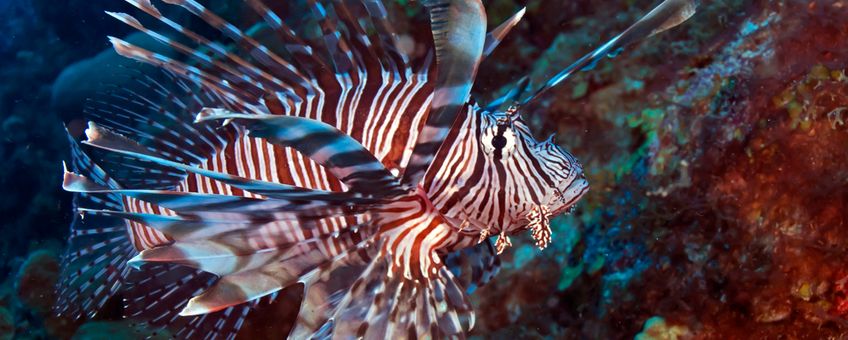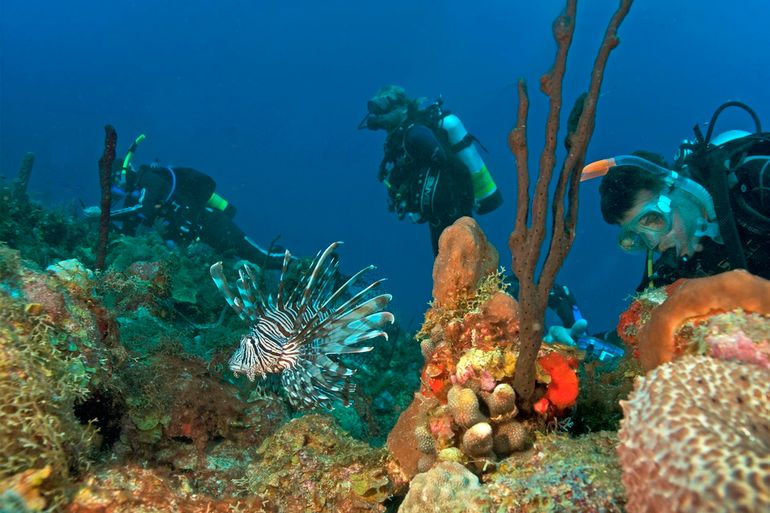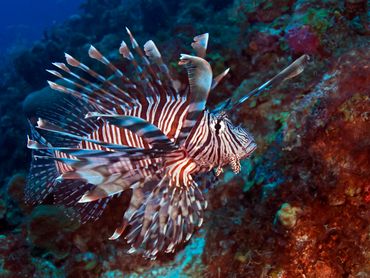
It is believed that the first lionfish were introduced off the southern coast of the United States, and then proceeded to spread southwards. For Bonaire, this gave the island time to implement a lionfish control plan prior to the first appearance of lionfish. This control plan hinged on spreading public awareness and providing local divers with the information they would need in the event that a lionfish was spotted in local waters. Within six months, the first lionfish had been spotted and the control plan was able to shift from purely informative to a more active role of monitoring and removing these fish.
At first, divers were given markers which could be used to indicate areas on the reef where lionfish had been spotted. Once back on land, they could contact the Bonaire National Marine Park (BNMP). Once the marine park rangers were made aware, they could go out to these markers and look for the lionfish, which could then be removed using a simple net. By the end of the year, BNMP began training volunteers to remove lionfish on their own.
In 2011, a new tool was on the market to make lionfish removal safer and easier. The E.L.F. (Eliminate Lionfish) tool allowed divers to puncture the lionfish without the need for a spear which has been known to cause damage to the reef or other marine life when divers misuse them. In 2012, dive schools began offering lionfish hunting courses, which would allow visiting divers to become trained and certified to help out. Soon restaurants were able to begin promoting lionfish specials on their menu: at its peak, the largest restaurant managed to serve over 960 kilogram of lionfish in 2014.

STINAPA's lionfish density surveys started in 2011, tracking 24 locations on Bonaire and 12 locations on Curaçao. These surveys measured lionfish densities along a 200 m2 transect, at three different depths (15, 25 and 35 meter deep). These annual surveys found that the number of lionfish was significantly larger around Curaçao than around Bonaire back in 2011. Over the following three years, this population on Curaçao began to fall, whereas the density of lionfish around Bonaire remained relatively constant. It was also found that although there were small shifts between the years of 2011 and 2018, the relative population of lionfish was slightly higher at deeper depths with an exception of 2018, which showed the highest density at 15 meter. When comparing between fish and unfished areas, it was found that unfished areas had larger lionfish populations densities. Overall, the average size of lionfish has been decreasing over time, which could be a result of successful hunting campaigns removing older lionfish from the population.
 Lionfish densities outside of recreational dive limits seem higher, but long-term data is missing to draw conclusions on trends at these deep depths. Although some of these lionfish could be hunted by specialty trained technical divers, this too has its own risks and concerns. Another option to consider is the use of traps. These traps would be located outside of recreational dive limits and would require regular monitoring to ensure other species have not been inadvertently caught.
Lionfish densities outside of recreational dive limits seem higher, but long-term data is missing to draw conclusions on trends at these deep depths. Although some of these lionfish could be hunted by specialty trained technical divers, this too has its own risks and concerns. Another option to consider is the use of traps. These traps would be located outside of recreational dive limits and would require regular monitoring to ensure other species have not been inadvertently caught.
Overall, current monitoring and removing procedures have managed to keep the local lionfish population growth to a minimum within recreational dive limits. Areas inaccessible to divers, such as in the reserved areas, still require monitoring by marine park staff. Thanks to the hard work of BNMP and their dedicated patrol of volunteers, local lionfish populations have been kept under control.
Text: Jessica Johnson, Tineke van Bussel, DCNA & Paulo Bertuol, STINAPA Bonaire
Photos: Marion Haarsma
